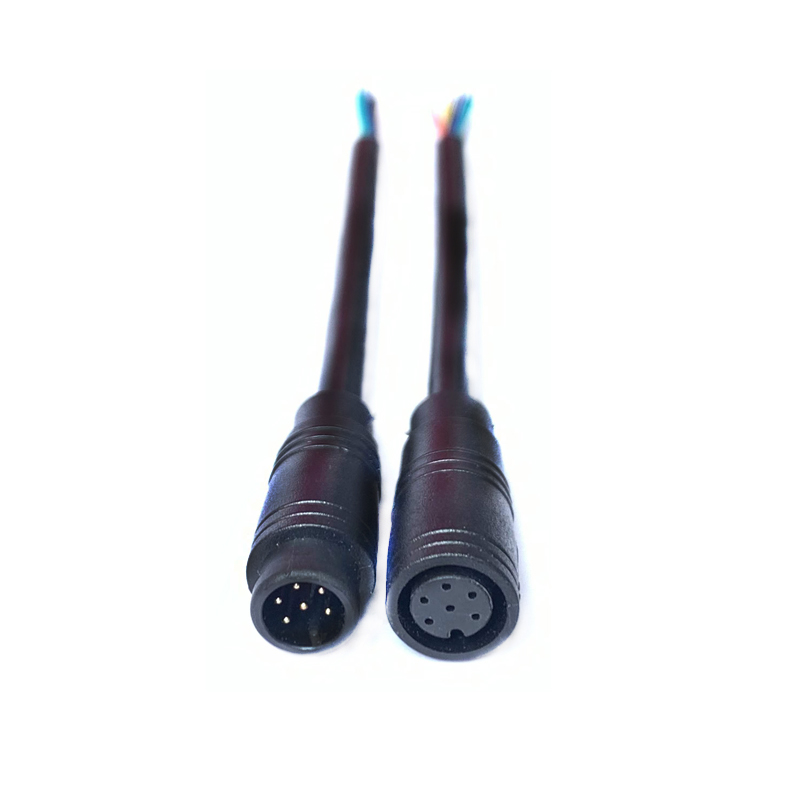News


News

5 Common Issues with 6-Pin M8 Waterproof Connectors and How to Solve Them
Release time:2025-04-25
viewed:328
6-pin M8 waterproof connectors are widely used in industrial automation, robotics, and outdoor sensors due to their compact size, IP67/IP68 ratings, and reliable performance. However, improper installation, harsh environments, and material limitations can lead to unexpected failures. This article explores the 5 most common issues with 6-pin M8 connectors, backed by real-world cases and data-driven solutions.

Damaged O-rings: Cracks or cuts from improper installation tools (e.g., using screwdrivers to force seals).
Incorrect Material: EPDM seals degrade in oil or high-temperature (>125°C) environments.
Loose Threads: Under-tightening (torque <0.4N·m) leaves gaps; over-tightening (torque >0.8N·m) crushes seals.
Use FKM (fluorocarbon) seals for chemical/oil resistance.
Tighten connectors to 0.5–0.7N·m with a torque wrench.
Apply silicone grease (e.g., Dow Corning DC4) to O-rings before installation.
Unshielded Cables: Non-shielded M8 connectors allow EMI from motors or VFDs to disrupt sensor signals.
Poor Grounding: “Pigtail” grounding raises impedance (>1Ω), reducing shielding effectiveness.
Data Insight: Unshielded 6-pin M8 connectors in a CNC machine caused 12% data packet loss. Switching to shielded models reduced errors to <0.1%.
Choose 360° shielded connectors with metal shells.
Ground the shield layer directly to the connector body (impedance <0.1Ω).
Humidity Exposure: Salt spray or high humidity oxidizes tin-plated pins (contact resistance ↑500%).
Mixed Metals: Copper pins with aluminum terminals create galvanic corrosion.
Test Data: Tin-plated pins in coastal environments showed 50mΩ resistance after 6 months vs. 5mΩ for gold-plated pins.
Use gold-plated pins (≥0.5µm thickness) for humidity-prone areas.
Clean contacts annually with isopropyl alcohol wipes.
Loose Cable Strain Relief: Unsecured cables fatigue pins during vibration (ISO 16750-3 standard requires 10Grms).
Plastic Fatigue: Repeated mating cycles crack polyamide housings.
Failure Example: A robotic arm’s M8 connector pins bent after 10,000 cycles due to inadequate strain relief.
Install spring-loaded strain relief boots (e.g., Lapp Unitronic).
Choose PPS plastic housings for higher tensile strength (vs. standard PA6).
High Heat: PA6 housings deform >120°C, misaligning pins.
Sub-Zero Temperatures: Standard seals harden below -25°C, losing elasticity.
Case Study: Solar farm sensors using PA6 M8 connectors warped in desert heat (60°C ambient + 30°C load). Switching to PPS housings eliminated deformation.
For high temps: Use PPS housings (heat resistance up to 220°C).
For cold temps: Opt for silicone seals (functional down to -60°C).
Monthly: Inspect seals for cracks; measure contact resistance (<10mΩ).
Quarterly: Test insulation resistance (>100MΩ) with a megohmmeter.
Annually: Reapply silicone grease and re-torque threads.
6-pin M8 waterproof connectors are critical for industrial systems, but their performance hinges on proper selection, installation, and maintenance. From seal failures in high-pressure washdowns to EMI interference in sensor networks, understanding these common issues empowers engineers to preempt failures and optimize uptime.
Key Takeaways:
Prioritize material compatibility (FKM seals for chemicals, gold plating for humidity).
Never underestimate shielding and grounding—critical for signal integrity in noisy environments.
Follow torque specifications and strain relief best practices to avoid mechanical stress.
Adopt a preventive maintenance schedule to catch issues before they escalate.
By adhering to manufacturer guidelines and industry standards like IP68 and ISO 16750, you can maximize the lifespan of your 6-pin M8 connectors, even in the harshest conditions.